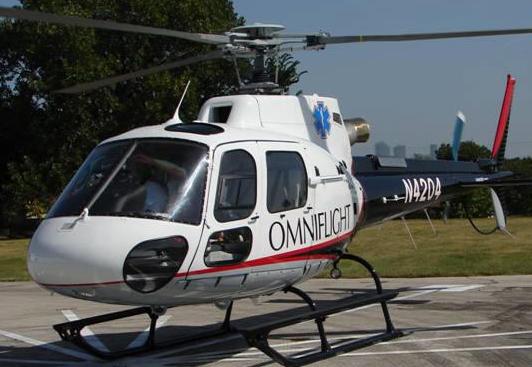
 |
NEWSROOM |
|
|
|
||||
|
Medical Helicopter Goes Down Killing All On Board By Mike Mitchell |
||||
 |
September 28, 2009, Omniflight Helicopters, Inc confirmed that an American Eurocopter AS350B2 helicopter, which took off from the Charleston, S.C. airport at approximately 2308 PM, ET on Friday, September 25, 2009, crashed shortly after takeoff 63 miles southwest of Conway, S.C. All three people on board were fatally injured in the tragic accident including Patrick Walters, 45, pilot; Diana Conner, 42, flight nurse; and Randolph Claxton Dove, 39, flight paramedic. The aircraft was headed to Conway, S.C. (where the aircraft is based) and was reported missing shortly after take-off from the Charleston, S.C. airport. A search was initiated shortly after the aircraft failed to report in to Omniflight’s communications center. A search was initiated shortly after the aircraft failed to report in to Omniflight’s communications center. |
|||
|
The National Transportation Safety Board (NTSB) and Federal Aviation Administration (FAA) representatives were sent out to the crash site. NTSB Air Safety Investigator Todd Gunther has been designated as Investigator-in-Charge. NTSB Board Member Robert Sumwalt will serve as principal spokesman during the on-scene investigation. The company is working closely with the NTSB as they conduct a full investigation. The National Weather Service reported thunderstorm had moved through the area shortly before the crash. Omniflight Helicopters, corporate offices are located in Addison, Texas. Omniflight Helicopters is a leading provider of air medical services throughout the United States. The company operates 100 aircraft nationally from 72 bases in 18 states, with a strong presence across the Southwest, Midwest and Southeast. The company has reported they are deeply saddened by the tragic loss of its crew members and wishes to express its deepest regrets and sincerest condolences to the families and friends of those who lost their lives. The Eurocopter AS350 Ecureuil ("Squirrel") is a single-engine light helicopter originally manufactured by Aérospatiale (now part of Eurocopter Group). The AS350 is marketed in North America as the AStar. The AS355 Ecureuil 2 is a twin-engine variant, while the Eurocopter EC130 is a derivative of the AS350 airframe. Development of the Eurocopter began in the early 1970s to replace the Alouette II, and the first flight took place on 27 June 1974. Despite the introduction of the EC130, production of the Eurocopter AS350 remains strong. Both single and twin-engine versions have been built under license by Helibras in Brazil. The Eurocopter AS350 B2 is the higher gross weight version powered by one Arriel 1D1 engine over the B1 version with aerodynamic strake fitted to tail boom along the starboard side and angled engine exhaust duct for better yaw control. |
||||
|
The NTSB has had a longstanding concern of Helicopter emergency medical services (HEMS) safety. In 1988, the Board adopted a Safety Study, Commercial Emergency Medical Service Helicopter Operations, which reviewed 59 HEMS accidents that occurred from 1978 through 1986. From that study, the Board issued 19 safety recommendations to the FAA, the National Weather Service, and two associations. These recommendations covered issues of training and guidance, operating rules, onboard equipment, industry coordination, and workload and fatigue. The majority of these recommendations have been closed acceptable action. The late 1990s and early 2000s saw a rapid growth of HEMS operations and the number of accidents began to rise. Prompted by this rise, the NTSB completed a special investigation report on Emergency Medical Services Operations in January 2006. This report analyzed 55 EMS accidents (41 of which were HEMS accidents and 14 airplane EMS accidents) that had occurred during the previous 3 years, claiming 54 lives; of these, 39 fatalities occurred during HEMS operations. Analysis of the accidents indicated that 29 of 55 accidents could have been prevented with corrective actions identified in the report. Immediately following adoption of the 2006 special investigation report, the number of HEMS accidents decreased. In calendar year 2006, 3 fatal HEMS accidents occurred with a total of 5 fatalities. The following year, there were 2 fatal HEMS accidents with a total of 7 fatalities, but in calendar year 2008, there were 8 fatal HEMS accidents, with a total of 29 fatalities. This was deadliest year on record for HEMS operations. Prompted by this recent rise in the number of fatal HEMS accidents, the Safety Board held a 4-day public hearing this past February to address the issues associated with HEMS safety. The hearing called upon 41 expert witnesses, representing 8 HEMS operators, 12 associations, 6 manufacturers, and 4 hospitals. Additionally, several organizations had an opportunity to question the witnesses directly. These parties, who were designated for their technical expertise in their respective fields, were the FAA; the Helicopter Association International (HAI); the Association of Air Medical Services; the Professional Helicopter Pilots Association; the National EMS Pilots Association; Air Methods; and CareFlite. A complete summary of the public hearing testimony, all of the exhibits, and the entire written transcript can be found on the NTSB’s web site. As a result of the hearing on September 1, 2009, the NTSB identified the following safety issues:
The NTSB is issued the following safety recommendations: To the Federal Aviation Administration
To Public HEMS Operators
To the Federal Interagency Committee on Emergency Medical Services
To the Department of Health and Human Services’ Centers for Medicare & Medicaid Services
|
| ©AvStop Online Magazine Contact Us Return To News |